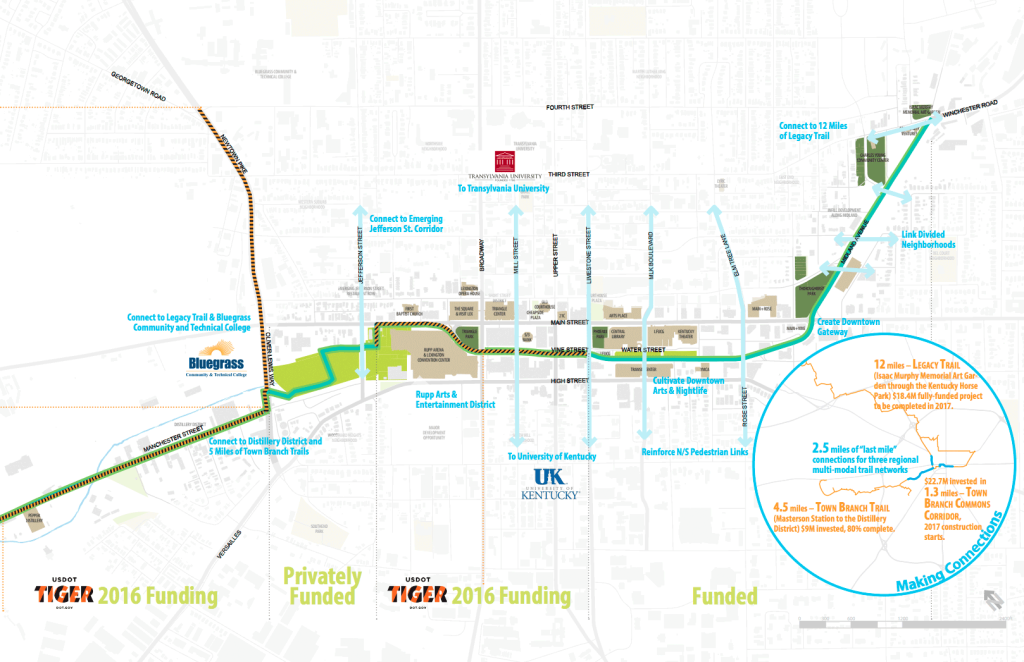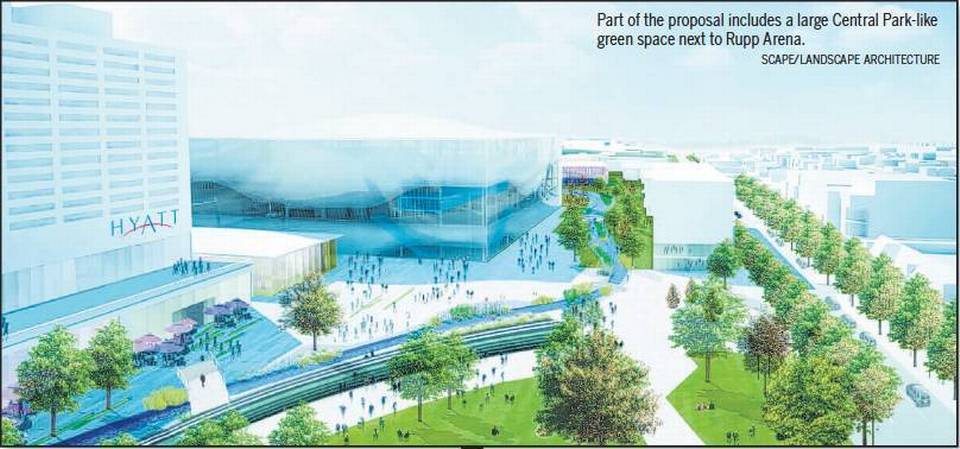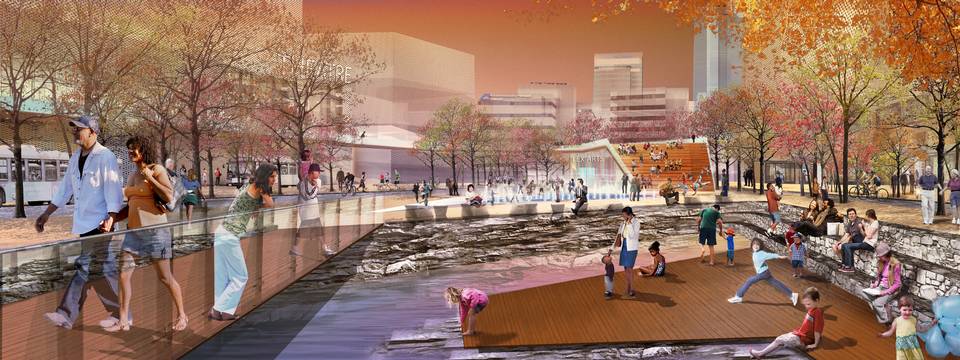Construction of key sections of both the Town Branch and Legacy trails will begin in 2016 as Lexington works toward connecting its two longest trails to make a continuous 20-mile loop from horse country through downtown and back to its rural landscape.
City officials say the remaining two-mile section of the Legacy Trail from Jefferson Street to the Isaac Murphy Memorial Art Garden will begin construction this summer, which will complete the nearly 12-mile trail.
Construction will begin on a four-mile section of Town Branch Trail from Alexandria Drive to Manchester Street and Forbes Road in 2016, city officials said last week.
Those six miles of trails will be the most trail miles the city has constructed in the past six years. The four-mile stretch of Town Branch will be built in three sections and cost a little less than $6.5 million, which will be paid for through state-federal funding. The two-mile segment of the Legacy Trail section will cost $3.7 million. It too will be paid for with state-federal transportation funds.
It’s taken more than a decade for Lexington to get its now-popular trail system off the ground as acquisition of land, the complexities of building trails through downtown, and a lack of funding have forced the two trails to be completed in sections.
Town Branch Trail’s first half-mile paved stretch for walking and biking, which starts near Masterson Station on the city’s northwest side, opened in fall 2005. An 8.5-mile portion of the Legacy Trail — from the North Loudon YMCA to near the Kentucky Horse Park— opened in September 2010. That project was completed in anticipation of the 2010 Alltech World Equestrian Games. Federal stimulus and other funding helped the city develop and build the 8.5-mile section.
THE VERY FIRST MEETING WE HAD PEOPLE WHO THOUGHT THESE TRAILS WERE GOING TO BE A ROUTE FOR TERRORISTS … . THEY THOUGHT THESE PATHS ARE ONLY GOING TO BE USED BY CRIMINALS. NOW, THE WHOLE MIND-SET HAS SHIFTED.  -Van Meter Pettit, president of Town Branch Trail Inc.
Over the years, the city has added additional miles to both trails as funding trickled in.
Van Meter Pettit, president of Town Branch Trail Inc., said that when the idea of a continuous trail system was first discussed more than a decade ago, Lexington residents were suspicious.
“The very first meeting we had people who thought these trails were going to be a route for terrorists … . They thought these paths are only going to be used by criminals,†Pettit said. “Now, the whole mind-set has shifted.â€
The city knew the trails were popular but now has numbers to prove it.
In September, new electronic counters on the Legacy Trail clocked 13,509 trips by bicyclists.
“That does not include pedestrians,â€said Keith Lovan, a city engineer who has overseen the design and construction of the Legacy and Town Branch trails. “We are in the process of trying to determine how many pedestrians are on the trail based on the number of bicyclists.â€
Lovan said the development of the trail system has been slow because Lexington is creating a 20-mile trail loop through some land it doesn’t own and must navigate creeks, railroads, utilities and state highways. Many cities have converted former railroad lines to trails, which is much easier.
Pettit agreed.
Town Branch Trail goes through one of the oldest commercial corridors in Kentucky.
“That is infinitely harder than rail to trail,†Pettit said. “It takes an enormous amount of cooperation. Most would say it was impossible, and it’s a great testament to Lexington that we have been able to get this done.â€
Town Branch
In September 2014, then-Gov. Steve Beshear announced $6.5 million in state-federal funding for a nearly four-mile stretch of Town Branch Trail.
Town Branch Trail is now complete from Masterson Station to Alexandria Drive. That $6.5 million will be used to build the next three phases of the trail. Construction probably will begin on the next section — phase 3, from Alexandria Drive to Bizzel Drive — in the spring, said Lovan. The fourth phase, a very short section, will cost $1.01 million. It will pass under a bridge that the Kentucky Transportation Cabinet rebuilt as part of the New Circle Road widening project.
“That has already been completed,†Lovan said of the bridge.
Another key portion of Town Branch Trail will include a rebuilt intersection into McConnell Springs on Old Frankfort Pike. Because that’s a state road, the city has to work with the Transportation Cabinet to redo that intersection, which the city hopes will include a traffic light.
“We are making improvements to the actual intersection,†Lovan said. “We are also rebuilding the entrance into the fire training center (which is across the street). All of that has to be completed before we do the trail.â€
THE CITY HAS AN ENGINEERING REPORT ON THE FINAL SEGMENT OF TOWN BRANCH TRAIL (FROM FORBES ROAD TO OLIVER LEWIS WAY) THAT SHOWS COSTS FOR THAT PORTION OF THE TRAIL PROBABLY WILL BE $13 MILLION TO $15 MILLION.
That pedestrian-friendly intersection into McConnell Springs will be a boon not only for trail users but for the park, Pettit said. McConnell Springs is tucked behind heavy industry on Old Frankfort Pike. To get there, people have to drive. Once that intersection and that key connector are finished, more people will find their way to McConnell Springs.
“If they are connected to greenways, the use of these parks goes way up,†Pettit said.
The three sections will be constructed at the same time, Lovan said. That way if a hiccup occurs, one problem won’t bring construction of the entire trail to a standstill, he said.
Lovan said he hoped the four-mile section would be completed in 2017. But because construction involves so many moving parts, a completion date is difficult to predict, Pettit said.
At the same time construction continues on the Town Branch, the city will be seeking funding for the final segment of the trail from Forbes Road to Oliver Lewis Way.
The city has an engineering report that shows costs for that portion of the trail probably will be $13 million to $15 million.
Lovan said the city would be going after city-federal transportation grants and any other type of funding to get that key section of the trail — which includes the Distillery District on Manchester — funded.
“We will continue to apply for grants and looking for whatever sources of funding we can find,†Lovan said. “We’ve broken it down into smaller sections in order to find money to fund it.â€
Town Branch Commons
City officials have said they hope construction on the downtown portion of the Town Branch Trail, the Town Branch Commons, also will begin in 2016.
$10 million bond money for Town Branch Commons in this year’s city budget
Although Town Branch Commons is funded differently from the Town Branch Trail, it is part of the eight-mile Town Branch trail system. Mayor Jim Gray has pushed for its funding and construction for the past several years. The city set aside $10 million in bond money for the project in this year’s budget. In addition, Beshear pledged nearly $6 million in state-federal transportation money for the Commons, which will include not only a trail but a series of pocket parks when completed. In addition, the city has applied for a $5.6 million low-interest state loan.
When completed, Town Branch Commons will stretch from the Isaac Murphy Art Garden — a trail head for the Legacy Trail —to Oliver Lewis Way — the beginning of the Town Branch trail’s rural section.
With the state money, construction on a section of the Commons will begin along Midland Avenue in 2016, city officials have said.
In addition to state and federal money, the city hopes to raise more than $50 million in private money to build the pocket parks along the Commons and to pay for other amenities.
Legacy Trail
The two-mile remaining section of the Legacy Trail from Jefferson to Fourth streets will mean moving the trail onto city streets. That also will mean the loss of some on-street parking. The city held public meetings to inform people who live in the area of the trail, but those meetings were not well attended, Lovan said.
He said the city is going to follow up with letters to affected residents to ensure people know about possible changes and the loss of parking to make room for the trail on Fourth Street. Transylvania University received a grant from the state to cover portions of the trail that goes on its property. Transylvania also is providing a match for that funding, Lovan said.
“We will have markers on the street and we’re going to be painting the bike lanes green,†Lovan said. “It will impact people mostly on Fourth and Third streets.
“We plan to have more public meetings possibly in March and April and then get started sometime in the spring or summer of 2016.â€
In addition, the state — which owns the Kentucky Horse Park — is in the process of building an additional 1.8-mile section of the trail from the park. Currently the trail ends at the Fayette County line, Lovan said.
Once completed, people will be able to travel from Masterson Station through downtown to the horse park on foot or by bicycle, Pettit said.
“That’s unique not only in Kentucky but also in the country,†Pettit said. “We are able to go from horse country through downtown and then back out to horse country.â€





